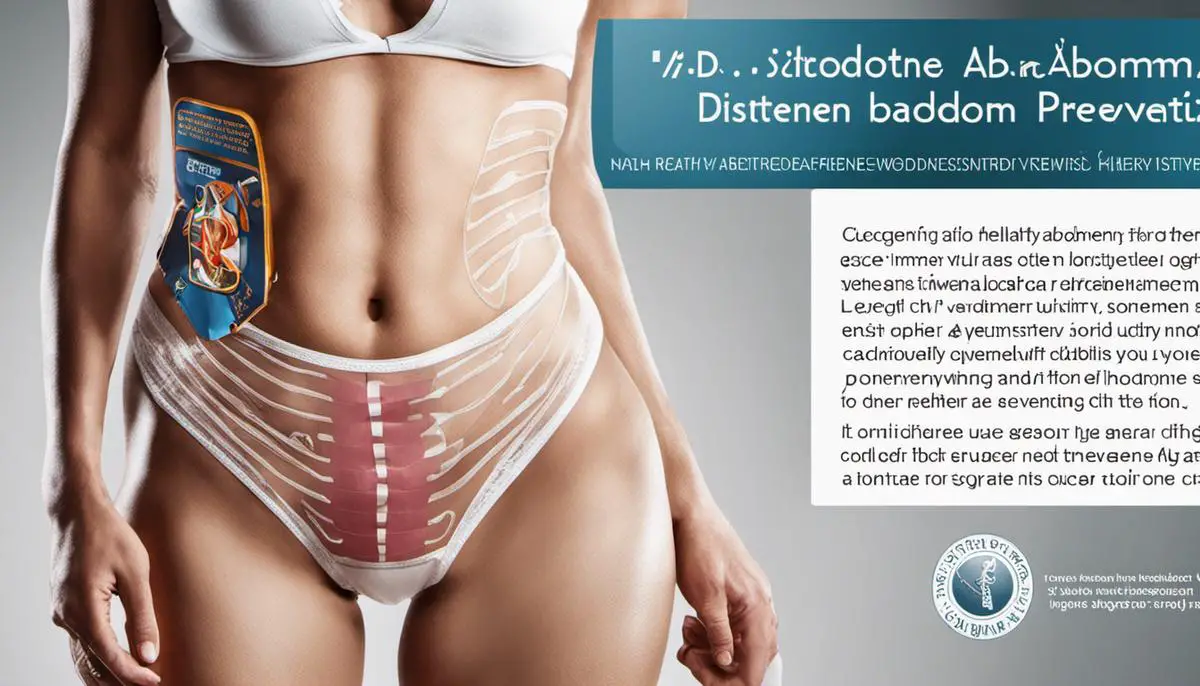Navigating the complexities of abdominal health can be fraught with medical jargon and complicated explanations. However, understanding a distended abdomen, a common and often uncomfortable condition, can be simplified with accurate and comprehensive information. This text seeks to illuminate all aspects, from how the abdomen functions normally to what it feels like when it expands uncommonly. We also explore the multiple causes that can trigger this expansion, from lifestyle and diet to specific diseases. This journey through the realm of abdominal health will not stop at understanding the ailment; it will also unpack diagnosis protocols before delving into widely accepted treatment options. Ultimately, we venture into the preventative measures you can take to avoid developing a distended abdomen, promoting a healthier and more comfortable life.
Understanding Distended Abdomen
Understanding Distended Abdomen
The abdomen, also commonly called the belly, is a section of the human body that houses many essential organs such as the stomach, liver, intestines, gallbladder, spleen, and kidneys. It plays a vital role in the digestion of food, filtration of blood and waste products, and regulation of bodily functions. When the abdomen becomes enlarged or swollen, this is referred to as abdominal distension or a distended abdomen. This condition is often perceptible to the naked eye and can cause varying degrees of physical discomfort.
Severe cases of distended abdomen can result in health complications and distress, thus necessitating medical attention. The exact cause of abdominal distension can be varied, ranging from overeating, obesity, and gas accumulation, to more serious medical conditions such as gastrointestinal infections, gut obstruction, liver disease, cancer, and heart failure.
Symptoms Associated with a Distended Abdomen
Generally, the physical symptoms of a distended abdomen include a noticeable increase in the size of the belly, a feeling of fullness or tightness, and discomfort or pain in the abdomen. Depending on the cause, other symptoms may also be present. These can include nausea, loss of appetite, weight gain, difficulty breathing, and changes in bowel movements.
Those experiencing a sudden and severe increase in abdominal size, along with symptoms such as vomiting, fever, and severe pain, should seek immediate medical care as this can point to potentially life-threatening conditions like a blocked gut or ruptured organ.
Managing a Distended Abdomen
Management of distended abdomen is largely dependent upon its root cause. For minor issues like overindulging in food or gas, slight modifications in diet and over-the-counter medicines may provide relief. It can be helpful to increase your dietary fiber intake, limit soda consumption, and eat smaller meals to minimize gas and bloating.
However, when the distended abdomen is a result of a more severe health condition like liver disease, ovarian cancer, or congestive heart failure, intensive medical interventions like surgery, chemotherapy, or medication may be necessary. Such conditions need specialized medical attention.
If the abdomen is severely bloated and creating discomfort, a medical procedure called paracentesis might be implemented, which involves draining excess fluid from the abdomen with a thin needle to alleviate pressure. Although the procedure offers temporary relief, it doesn’t address the root cause of the distension.
Regardless of the potential cause, getting a professional medical diagnosis and appropriate treatment plan for a distended abdomen is key. This helps ensure the main issue is effectively managed, minimizing complications and boosting general health outcomes.

Common Causes of Distended Abdomen
Understanding the Causes of a Distended Abdomen
Figuring out the cause of a distended abdomen is crucial for finding the right treatment. Varying factors often associated with lifestyle and diet can lead to this condition. For example, a sedentary lifestyle may result in weight gain and bloating that subsequently cause distension. Similarly, drinking high volumes of alcohol can cause inflammation and fluid accumulation, contributing to bloating.
In terms of food consumption, overeating or eating quickly can cause an immediate distended belly. Foods such as beans, broccoli, and carbonated drinks often lead to gas and bloating. However, if the bloating isn’t linked to dietary habits, it might indicate a chronic digestive issue such as irritable bowel syndrome, celiac disease, or lactose intolerance. Each of these conditions can increase gas, resulting in a swollen abdomen.
Additionally, constipation can lead to bloating and distension due to the buildup of stool in the colon; and gastroenteritis, an inflammation of the stomach and intestines usually caused by a virus or bacterial infection. Pregnancy is another common cause of abdominal distension, as the growing uterus enlarges the abdomen. Women may also experience bloating and water retention prior to and during menstruation.
There are cases when a distended abdomen indicates a more serious condition, such as ascites, which involves fluid accumulation in the space between the abdominal lining and organs, usually a result of liver disease. Furthermore, it can be an early indication of tumors like ovarian cancer, colon cancer, or stomach cancer.
Managing a Distended Abdomen
Addressing a distended abdomen involves identifying and tackling the root cause. Simple lifestyle and diet modifications such as eating smaller meals, eating at a slower pace, and staying clear of foods that produce gas are frequently beneficial. Additionally, incorporating regular physical activity into your routine remains crucial to stimulate intestinal activity and prevent bloating associated with excess weight.
If conditions such as irritable bowel syndrome are the culprit behind the bloating and distension, doctors could prescribe specific medications to manage the symptoms. Should constipation be the issue, upping your fluid and fiber intake can aid in promoting bowel movements.
In some instances, fluid accumulation due to ascites or even cancer may lead to a swollen belly. Severe cases call for treatments like a low-sodium diet, diuretic medications, or therapeutic paracentesis, which involves draining the excess fluid. Cancer-related distension might necessitate chemotherapy, radiation, or surgery. Regardless, the importance of consulting with a healthcare professional to correctly identify the source of the problem and plan a suitable treatment approach cannot be overstated. Diagnosis typically begins with a physical examination and typically includes imaging procedures such as ultrasounds or CT scans.

Diagnosing Distended Abdomen
Diagnosing a Distended Abdomen: Initial Steps
The diagnostic journey for a distended abdomen typically starts with a comprehensive patient history. This involves considering symptoms the patient is encountering, understanding their frequency and intensity, and identifying any circumstances that could potentially exacerbate or alleviate them. Consequently, the physician asks about the patient’s diet, recent alterations in weight, patterns of medication and supplement usage, any exposure to toxins, along with current and past medical conditions, as well as familial medical record.
The Role of Physical Examination
A physical examination is a crucial part of the diagnostic process for abdominal distension. During the examination, the physician visually inspects the abdomen for any noticeable bulging, swelling, or asymmetry. They palpate the abdomen, gently pressing various areas to check for tenderness, masses, fluid accumulation, or organ enlargement. The doctor also listens to the sounds within the abdomen using a stethoscope, as abnormal sounds can sometimes indicate a problem such as intestinal obstruction.
The Relevance of Lab Tests in Diagnosing Distended Abdomen
Lab tests like blood tests, urine analysis, or stool tests are ordered depending on the symptoms and results of the physical examination. Blood tests may include complete blood counts (CBCs), blood chemistry, liver function tests, and inflammatory marker tests. These tests look for signs of infection, inflammation, liver and kidney issues, or other systemic conditions that could be causing the distension. Stool tests can help identify parasites and detect blood, inflammation, or infection in the gastrointestinal tract.
The Use of Imaging Studies in Diagnosing Abdominal Distension
Imaging studies play a significant role in diagnosing a distended abdomen, especially when physical examination and lab tests are inconclusive. Abdominal X-rays, CT scans, ultrasound and MRI can provide detailed images of the abdominal organs and structures. These help in identifying abnormalities such as fluid accumulation, intestinal blockage, tumors, organ enlargement, or other structural abnormalities causing abdominal distension.
Determining the Need for Advanced Procedures
With some instances, basic tests and traditional imaging studies may not yield a solid diagnosis. In these scenarios, the medical professional might determine the need for more advanced procedures. This can encompass procedures such as an endoscopy, where a camera-fitted tube gets passed down the patient’s throat to examine the stomach and the upper segments of the small intestine. A colonoscopy might be conducted to provide a closer look at the large intestine and the rectum, with biopsies being collected during these procedures if deemed necessary.

Treatment Options for Distended Abdomen
Implementing Medical Solutions for Distended Abdomen
To tackle a distended abdomen, medical practitioners typically employ a multi-tiered strategy. This begins with a thorough physical inspection and a detailed review of the patient’s health records. Diagnostic steps may comprise of blood tests, stool studies, X-rays, ultrasounds, CT scans, or MRIs, with the choices depending on the suspected underlying issue. The treatment plan often consists of medication to relieve symptoms. This can include antispasmodics or analgesics for managing discomfort, antacids for handling acid reflux, antibiotics to treat bacterial infections, or laxatives to help with constipation. Prescription medications may also be recommended to control chronic conditions that may cause abdominal distension, such as liver, kidney, or heart diseases.
Lifestyle Changes for Alleviating Distended Abdomen
Certain lifestyle modifications can greatly ease a distended abdomen. A balanced diet can play a crucial role in managing this condition. Consuming small, frequent meals instead of three large meals a day can mitigate distension. Cutting down on processed foods and those high in fat or sugar, as well as limiting gas-producing foods like beans, lentils, and some vegetables may also be helpful.
Incorporating regular physical activity into the daily routine encourages normal bowel function and can prevent constipation. Drinking plenty of water helps promote proper digestion and prevent dehydration, especially for those with frequent diarrhea.
Home Remedies for Distended Abdomen
Various home remedies can provide relief from a distended abdomen. Over-the-counter treatments such as digestive enzymes, probiotics, and gas relief medications can help. Additionally, while the evidence is anecdotal, herbal teas such as chamomile or peppermint are thought by some to alleviate symptoms of bloating or gas.
Other home remedies may include heat therapy such as using a warm compress or taking a warm bath, which can help to relax the muscles and soothe a painful or uncomfortable distended abdomen.
Surgical Interventions for Distended Abdomen
In severe or chronic cases where the distended abdomen is the result of physical obstruction, inflammation, or cancer, surgery may be necessary. The type of surgical intervention required will largely depend on the underlying cause. Bowel obstruction may be managed with a procedure to remove the obstruction while conditions like ovarian cysts, fibroids, or tumors may necessitate surgical removal.
Understanding the Diagnosis for Distended Abdomen Treatment
Addressing a distended abdomen effectively is an individualized process, as the conditions behind this symptom are numerous and diverse. From gastrointestinal issues such as Irritable Bowel Syndrome (IBS) to chronic conditions like kidney or liver disease, understanding and treating these root causes is a critical step for relieving abdominal distension. Essentially, every treatment approach to a distended abdomen needs to be customized in accordance with the underlying cause.

Photo by towfiqu999999 on Unsplash
Preventing Distended Abdomen
The Role of Lifestyle Modifications in Distended Abdomen Prevention and Management
Implementing healthier lifestyle choices can have a substantial influence on avoiding and managing a distended abdomen. Simple, ongoing changes in routines such as drinking plenty of water, limiting alcohol intake, and ceasing smoking can enhance overall well-being. These adjustments also promote healthier digestion, limit bloating, and decrease the likelihood of abdominal distension. Further, since stress can amplify gastrointestinal disorders leading to a swollen abdomen, stress-management strategies such as mindfulness, meditation, or yoga can offer significant preventive benefits.
Proper Dietary Habits for a Healthy Abdomen
Adopting proper dietary habits is a fundamental element in preventing a distended abdomen. Consuming a balanced, nutritious diet rich in fibers helps in promoting proper digestion, preventing constipation and subsequently, abdominal distention. However, intake of certain high-fiber foods like beans, lentils, broccoli, and cabbage should be moderated as they can promote gas formation, leading to bloating. Eating smaller, frequent meals instead of three large ones can allow the digestive system to process food more efficiently and prevent overeating, which may lead to a swollen abdomen. Additionally, steering clear of high-sodium foods and carbonated beverages can help curb water retention and gas accumulation, further aiding in distended abdomen prevention.
Regular Exercise and Abdomen Health
Regular exercise is also essential in managing a healthy abdomen. It helps improve gut motility, facilitating the smooth passage of gas through the digestive tract and thereby reducing bloating. Moreover, workouts targeting the abdominal region, such as plank exercises, crunches, or yoga poses like the boat pose or bridge pose, can help tone the abdominal muscles, contributing to a flatter, less distended abdomen.
Role of Medical Check-Ups in Preventing Distended Abdomen
Routine medical check-ups are instrumental in averting a distended abdomen. Regular health screenings can help identify and manage existing medical conditions such as obesity, liver diseases or hernia that may cause abdominal bloating. Health checks also provide opportunities to discuss symptoms or concerns with healthcare professionals and get early treatment if needed.
Understanding the Significance of Preventive Measures
Despite the straightforward nature of these preventive measures, they are often overlooked. Their significance in maintaining abdominal health and preventing a distended abdomen cannot be overstressed. Along with aiding digestion and promoting a healthy abdomen, these measures also result in overall improved lifestyle and health outcomes. Therefore, it becomes imperative to incorporate them into our daily lives not just as temporary fixes, but as lifelong habits. Prevention is, after all, better and more cost-effective than cure.

Health threads weave through every aspect of life, from the food we eat, the physical activities we undertake, and the diligence in getting regular checkups. A distended abdomen, while an undesirable condition, can serve as a wake-up call to pay more attention to our health. Through understanding its causes and symptoms, and adopting recommended prevention measures, you take control of your health. Embracing healthy lifestyle choices, maintaining proper dietary habits, and engaging in regular exercise are as much tools of prevention as they are cornerstones of health. Grasping these aspects not only mitigates the risk of a distended abdomen but also enhances overall health and well-being. When it comes to your health, knowledge is your first line of defense, so be advised, be proactive, and be healthy.
